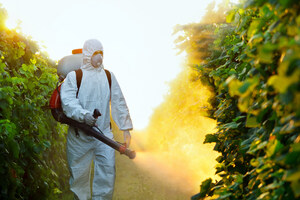 And another similarity: The Environmental Protection Agency (EPA) “almost bends over backwards to protect these products…despite legal and scientific evidence,” says Gillam. On the toxicity scale, dicamba is higher than glyphosate—the active ingredient in Roundup—and lower than 2,4-D, the third most common herbicide. But the EPA said “dicamba is not likely to be a human carcinogen.”
And another similarity: The Environmental Protection Agency (EPA) “almost bends over backwards to protect these products…despite legal and scientific evidence,” says Gillam. On the toxicity scale, dicamba is higher than glyphosate—the active ingredient in Roundup—and lower than 2,4-D, the third most common herbicide. But the EPA said “dicamba is not likely to be a human carcinogen.”There is one difference. “The EPA did not check all the dicamba boxes like it did with glyphosate, so the agency’s evaluation has come under question,” says Gillam. “How were they evaluating dicamba, and were they doing the wrong epidemiology? Even the Office of Research and Development within the EPA disagreed with its evaluation. So with dicamba, it’s more about how the EPA didn’t do their job.”
New dicamba research published in the International Journal of Epidemiology (May 2020) shows an association with increasing use of dicamba and lung and colon cancer. According to the National Pesticide Information Center, (NPIC) dicamba is found in over 1,100 products sold in the U.S. “When plants are treated with dicamba, they grow in abnormal and uncontrollable ways, and often, the plants die,” it says. Dicamba is so prevalent it has been found in “house dust in farmer's homes,” and the NPIC on its website describes signs of dicamba exposure in pets, including shortness of breath and muscle spasms. So what does this say about human exposure?
“Scientists have not found a clear link between dicamba and cancer in people. One study on pesticide applicators found weak links between lung and colon cancer and dicamba exposure, but other studies have not found any evidence of this. The EPA had concluded that dicamba is not likely to cause cancer in people.” “Had” is the operative word.
Monsanto doesn’t like Gillam. It even planned to target her, thanks to more than 22 years of reporting (mostly for Reuters) on the agrochemical industry, with a focus on Monsanto’s genetically engineered seeds and connecting its herbicides to human and environmental health problems. In 2017 she wrote the book Whitewash: The Story of a Weed Killer, Cancer, and the Corruption of Science, which was praised by the Society of Environmental Journalists and Erin Brockovich, to name a few. She exposes “secret industry communications that pull back the curtain on corporate efforts to manipulate public perception”, how Monsanto smeared the reputations of scientists for publishing research that contradicted business interests, and how regulators signed off on glyphosate and in so doing, assured consumers that the pesticide was safe.
Glysophate in Roundup
In August 2018, Gillam wrote in Huffington Post that government email communications showed Monsanto and the EPA in cahoots to stall a toxicology review on glyphosate (the key ingredient in Roundup) conducted by the Centers for Disease Control and Prevention. That same month the first Roundup trial ended with a jury awarding DeWayne Johnson $289.25 million in damages, including $250 million in punitive damages. The jury found that Monsanto’s Roundup was a substantial contributing factor in causing Johnson’s cancer. Monsanto, of course, appealed.
Dicamba Environmental Problem
Dicamba was developed because of glyphosate-tolerant crops such as soybeans. Here are a few facts.
- Environmental constant spraying has led to naturally-evolved resistance to the herbicide in many weed species – so-called “super weeds.”
- Over 90 percent of call cotton, soy and corn plantings in the U.S. are of glyphosate-tolerant GMO varieties
- The acres of farmland harboring glyphosate-resistant weeds nearly doubled between 2010 and 2012, from 32.6 million acres to 61.2 million acres.
Monsanto Ghostwriters
The Monsanto Papers includes documents revealing the company’s ghostwriting of an important paper and how Monsanto used that “independent” scientific literature to promote and defend its herbicides. A previous investigation found that Monsanto paid a number of ghostwriters to remove any mention of glyphosate’s toxicity from the safety reports published by the EPA.
Wait, it gets worse. “Colluding with regulators in Trump’s EPA to hide the cancer risks of Roundup is business as usual for Monsanto, but their deceitful and dangerous behavior shouldn’t be rewarded by the courts,” said EWG President Ken Cook, commenting on Edwin Hardeman’s appeal. (Hardeman successfully sued Monsanto in February 2016.) “[Monsanto] needs to be held responsible for the harm it has and is causing to an untold number of Americans.”
Monsanto acts like it is above the law. When California’s Office of Environmental Health Hazard Assessment tried to add glyphosate to the state’s list of known carcinogens, Monsanto tried to stop the governmental agency by suing it. And court documents have shown that Monsanto and Bayer knew about the risks but downplayed them to inflate profits. Health be dammed.
In March 2020, The Guardian reported that Monsanto predicted its dicamba crop system would lead to thousands of damage claims from US farmers but went ahead anyway, and risks were downplayed to the EPA.
READ MORE ROUNDUP CANCER LEGAL NEWS
The EPA and Monsanto did not mention that dicamba is associated with cancer, just like glysophate.
Carey Gillam is research director of U.S. Right to Know, a nonprofit investigative research group focused on the food industry. She is the author of the award-winning book, “Whitewash: The Story of a Weed Killer, Cancer and the Corruption of Science” and a veteran journalist, researcher and writer with more than 20 years of experience in the news industry.
